Michigan is the home of hundreds of bee species. Many of these are native species. Most of these have a positive role in pollination both in agriculture and for the environment. Others are known for parasitism.
Here are the most common types of bees in Michigan.
Table of Contents
1. Common Eastern Bumble Bee
The common Eastern Bumble Bee (Bombus impatiens) is the most widespread species in Michigan and North America.
These bees have a considerable pollination role in Michigan. Most of the species’ pollination benefits are tied to flowers.
The Common Eastern Bumble Bee pollinates a wide range of flowers such as asters and cirisium families of flowers.

Pollination happens when visiting one flower after another. The Common Eastern Bumble Bee eats pollen and nectar which is then turned into honey by regurgitation.
The bees are known for having an inner system that allows them to visit the same flower when the entire pollen hasn’t been consumed.
This makes the Common Eastern Bumble Bee efficient when foraging in the same area as it doesn’t constantly need to look for new sources of pollen to consume.
2. Western Honey Bee
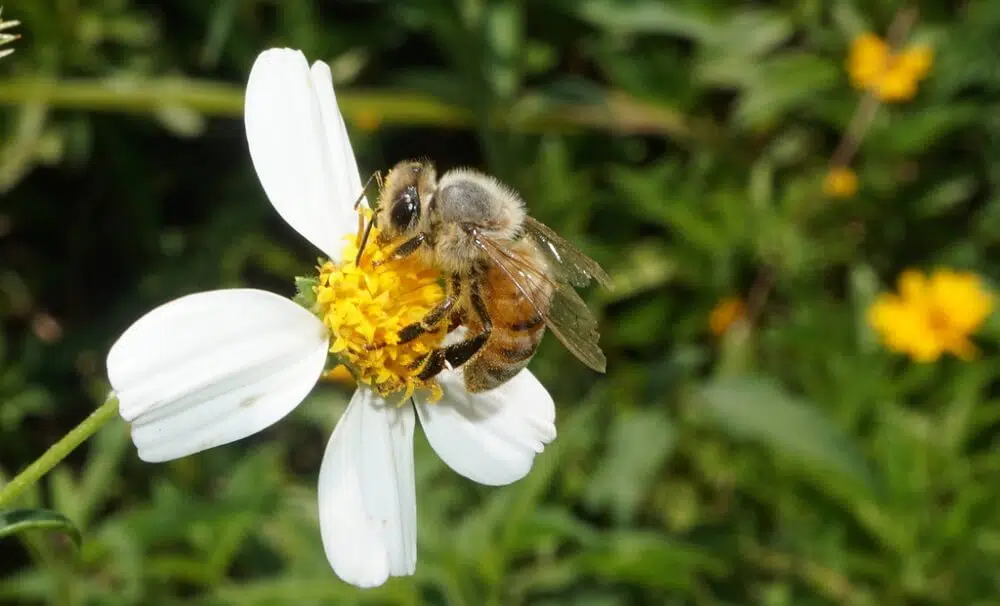
The Western Honey Bee (Apis mellifera) has local significance in apple pollination in Michigan. These bees are considered the most common apple pollinator and an efficient pollinator of other fruits.
The Western Honey Bee and bees, in general, represent a lesser option for blueberry pollination. However, this species is still easy to transport often being carried out of the state for blueberries.
These bees have been scientifically-studied for their role in evolution and memory. It turns out they have innate communication abilities,
For example, Western Honey Bee uses specific flight patterns and dance movements to communicate the distance and flight direction towards the nearest food source.
These bees have also been shown to have superior memory capacity to remember flower locations where they collect most pollen from.
The Western Honey Bee has economic significance. However, it’s also a threatened species. Varroa is a common type of Western Honey Bee infestation.
3. Eastern Carpenter Bee

The Eastern Carpenter Bee (Xylocopa virginica) is a common species in Michigan. It has a lesser role in pollination mainly because it has developed a technique that allows it to extract nectar without pollination through flower-piercing methods.
This bee is known to be social. Living in small groups, it’s a species where females are dominant.
There are just a few males in the nest, mainly known for their role in mating.
For mating purposes, the female Eastern Carpenter Bee needs to fly as mating happens in-air.
Females can sometimes stop the mating process by landing. The male pauses copulation when the female lands.
The Eastern Carpenter bee is known to mostly have a beneficial role in decorative flower pollination. They are mostly found in gardens and fields rich in flowers.
The Eastern Carpenter Bee is a species known for its beneficial role in blueberry pollination, unlike the Western Honey Bee which has poor results in pollinating blueberry.
4. Brown-belted Bumble Bee

The Brown-belted Bumble Bee (Bombus griseocollis) is common in Michigan where’s it’s a native species as in most US states. The species is recognized by its yellow-golden thorax and yellow circular lines around its body.
The bee has a beneficial role in the pollination of thistle, milkweed, and sunflower.
Queens is the first Brown-belted Bumble Bees that emerge in the spring. This species remains active until late July.
Males are mostly known for their role in inseminating queen bees.
Brown-belted bees aren’t a threatened species even if it has a few natural predators. The successful reproduction rate at almost any altitude makes these bees’ numbers increase year on year.
5. Two-spotted Bumble Bee
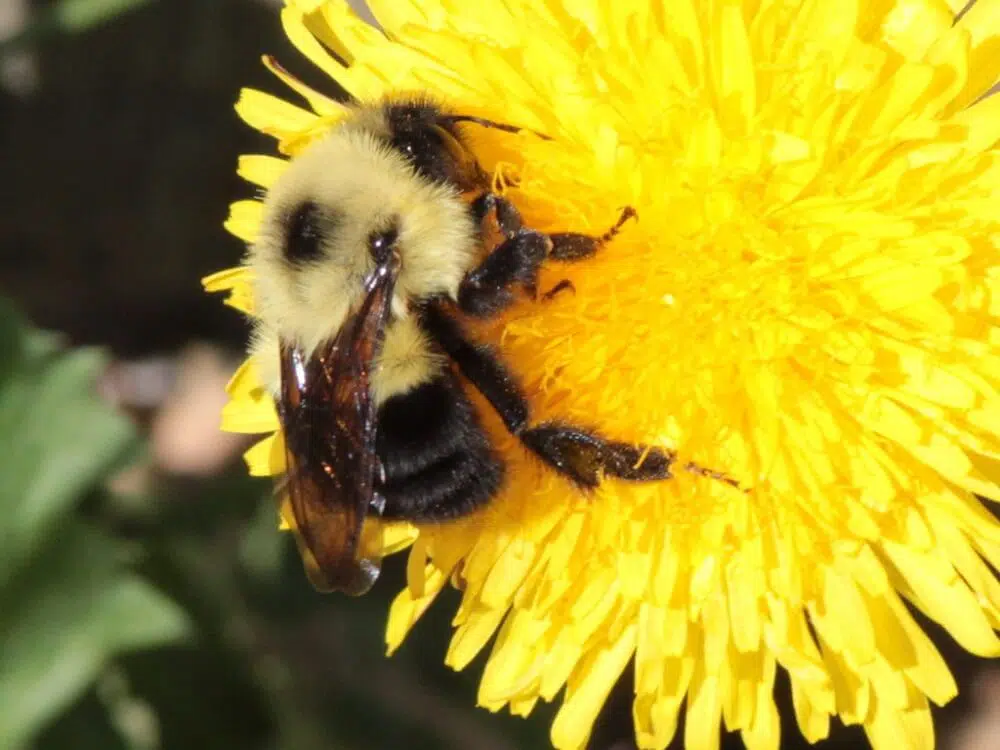
This bee (Bombus bimaculatus) is identified by its yellow spots on the abdomen and black-yellow body. It plays an important pollination role when foraging.
Plum and clover are among the species pollinated by the Two-spotted Bumble Bee.
These bees live in underground nests. These can be simple one-tunnel nests or larger multi-tunnel nests. When a nest has multiple tunnels these aren’t longer than one foot.
Queen bees entre hibernation alone at the end of the season. They typically hibernate in loose wood logs.
6. Tricolored Bumble Bee

The Tricolered Bumble Bee (Bombus ternarius) lives in colonies established and run by a queen bee. The species has a clear hierarchy that allows it to organize its colony to very specific standards.
Both young and mature bees are seen foraging. However, it’s mature bees that are normally inclined to forage in bad weather, presumably due to a higher experience.
These bees have also been shown to show pacing when collecting pollen. They rarely carry their maximum pollen load to increase efficiency.
The Tricolored Bumble Bee has been shown to visit the same flower up to 10 times per day to maximize pollen collection. This can be done without break or with frequent breaks.
There’s no precise range for these bees to fly towards from the nest. However, they are mostly within just a few miles from the nest to increase flying efficiency.
7. Pure Green-Sweat Bee
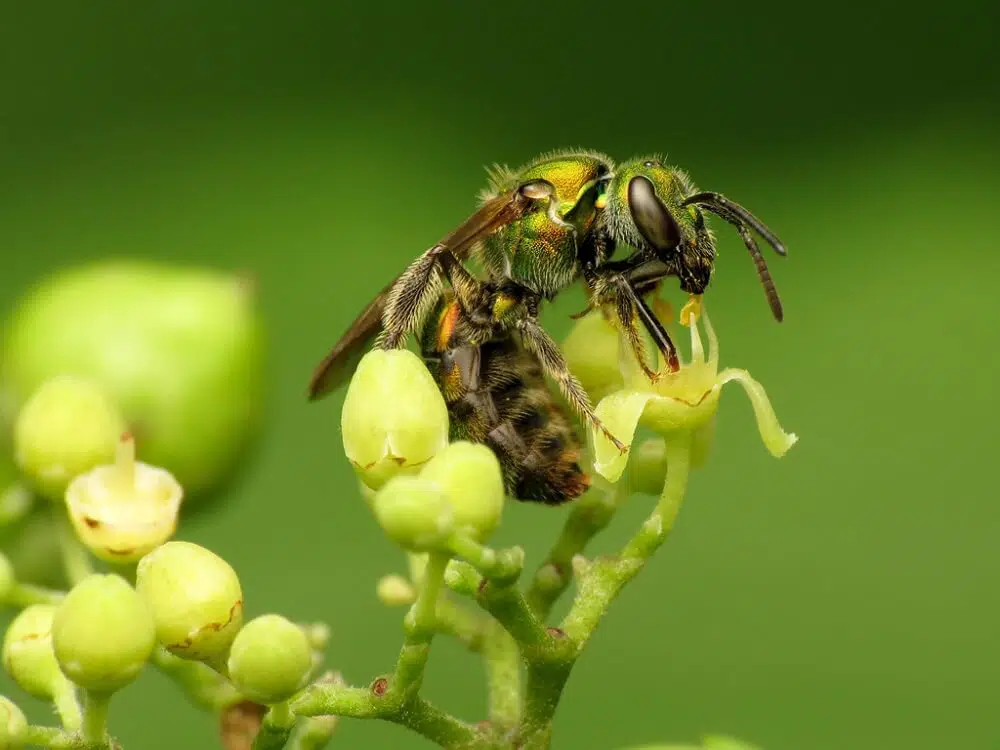
Purer Green-Sweat Bees (Augochlora pura) are known as one of the few walnut pollinator species. The bees live in colonies and they often nest in wood.
Males and females have clear roles they follow. Males are responsible for guarding and patrolling the nest as well as for mating.
Females take care of the nest and they collect pollen.
The Pure Green-Sweat Bee is interested in collecting pollen from more than 20 plants and flowers, particularly stopping at blooming blossom.
These bees have a metallic green color. Bright coloring makes them easily visible to natural predators.
Large flies and birds are among the common Pure Green-Sweat Bee predators.
8. Ligated Furrow Bee
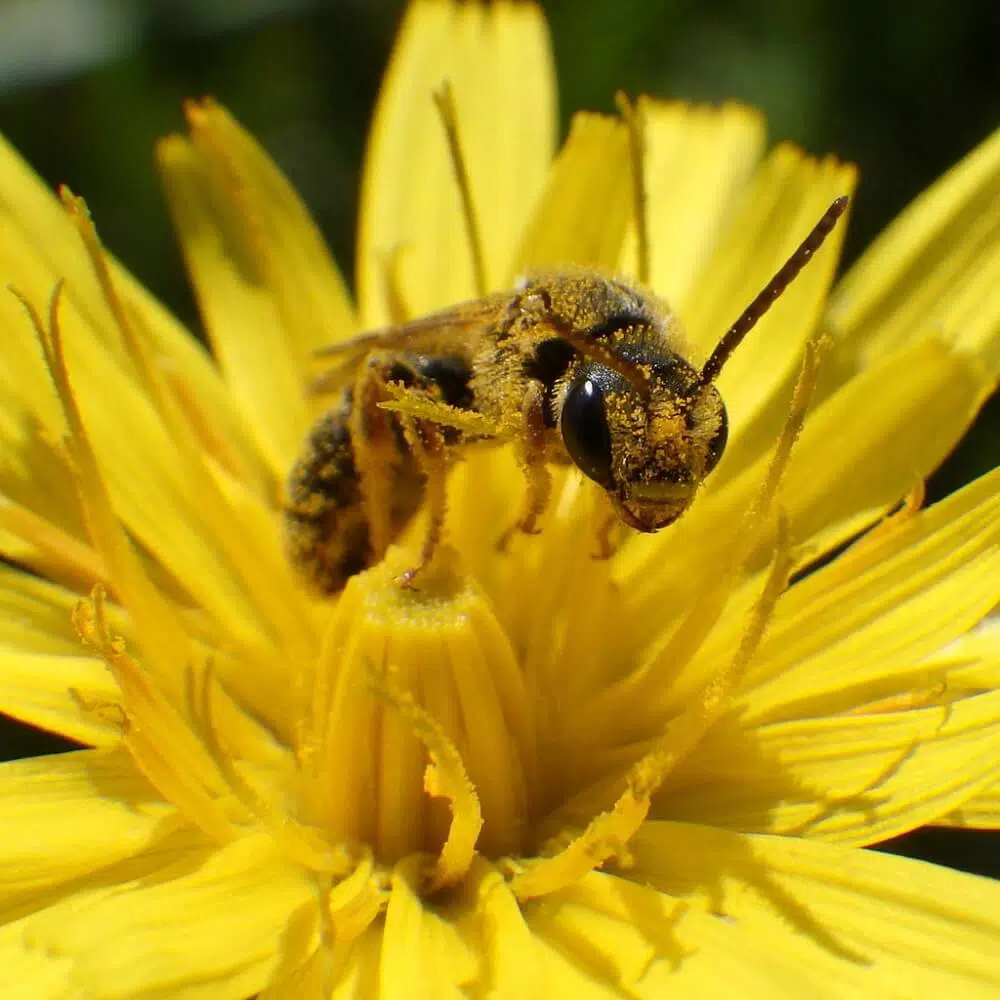
These common bees are known for high levels of aggression. It’s believed high levels of aggression are a resort for establishing hierarchy inside the nest.
Ligated Furrow Bees (Halictus ligatus) build underground nests or nest in burrows. The species have been shown to have the most reproductive success when returning to an existing nest the following season.
This is why high levels of aggression even with other bees of the same species are common as individuals try to establish themselves in an existing nest.
The species is otherwise known for being very efficient at collecting pollen from different plants. Pollen is stored as provisions in the nest.
9. Bicolored Striped Sweat Bee
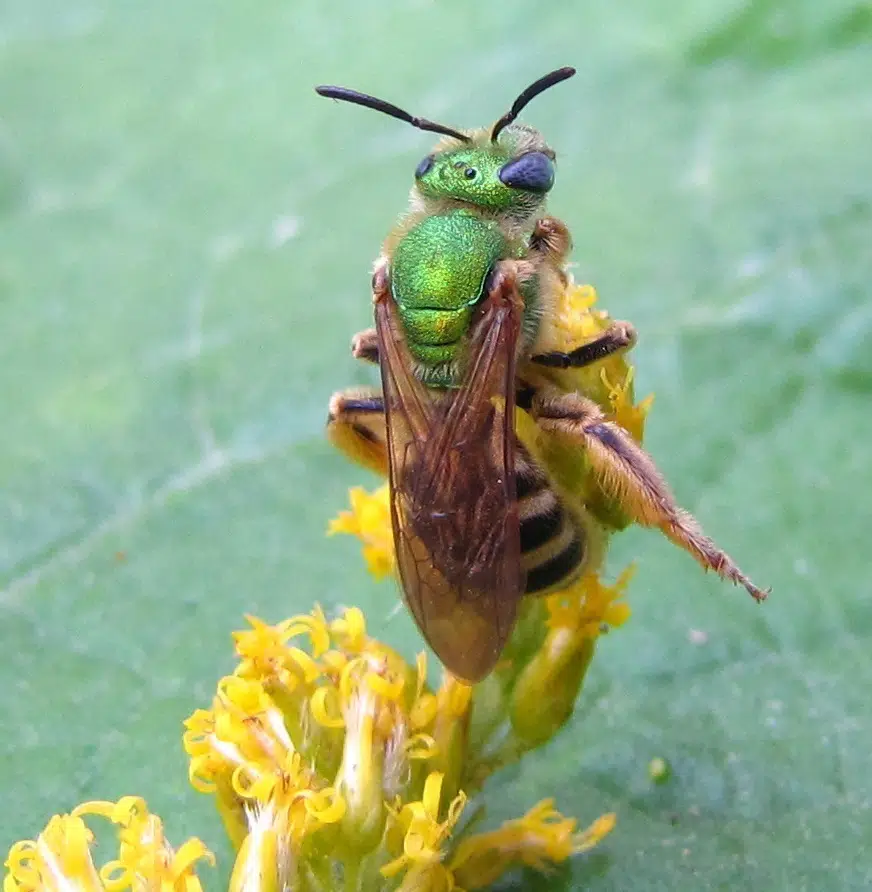
The Bicolored Striped Sweat Bee (Agapostemon virescens) is known for having a metallic green thorax and black and white striped abdomen.
Common in Michigan, the species is known for living individually rather than in nests. Each female digs a hole in the ground where it lays an egg it takes care of.
However, these burrows are often found in clusters of up to 30 for defensive purposes.
A female always remains behind to guard all of these individual burrows when others are out foraging.
The bees are often seen on sunflowers. Late in the fall females of the species hibernate while males die.
10. Lemon Cuckoo-Bumble Bee

The Lemon Cucko-Bumble Bee (Bombus citrinus) is common throughout the state and the entire North-East. This species is a known parasitic bee.
The species forages flowers such as thistle and asters. But its popularity comes from its parasitism.
The bee is a parasite to other species. It enters a nest where it kills the queen and asserts the dominance of the ovarian development of other female bees.
In the takeover process, the Lemon Cuckoo-Bumble Bee is also known for killing all eggs and larvae it finds inside the nest.
11. Half-black Bumble Bee
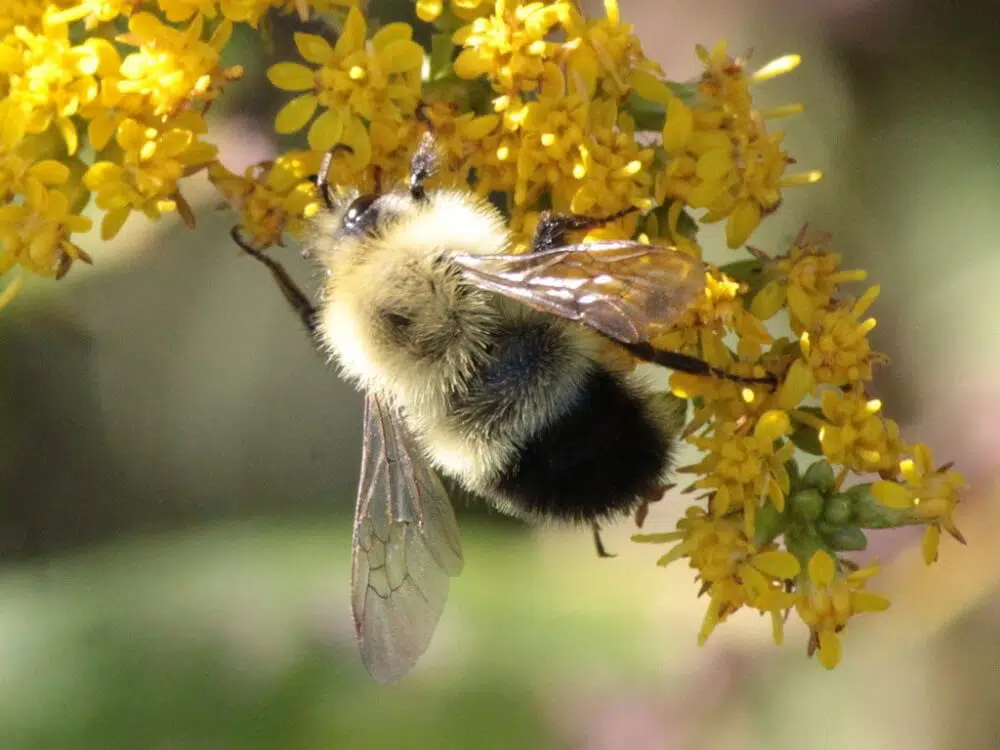
This species is sometimes seen on the ground as it nests inside the ground. The Half-black Bumble Bee (Bombus vagans) shares similarities with Two-the spotted Bumble Bee (Bombus bimaculatus).
Both these species are known for having interests in different flowers depending on the hierarchy inside the nest.
Queens are always interested in plum blossom which is prioritized over other flowers.
Worker bees are interested in red clover, thistle, and milkweed.
These bees sometimes carry the pollen from these flowers back to their underground nests.
Colonies are large as up to 70 bees can live in the same nest.
However, these nests need constant defending as they are seen as perfect targets by parasitism-orientated cuckoo bumblebees.
12. Two-spotted Longhorn Bee

Two light spots on the abdomen help identify this species. The Two-spotted Longhorn Bee (Melissodes bimaculatus) is one of the most common species in Michigan and other Northern states.
These bees have a positive pollination role. But they also collect pollen which is used as food for their larvae.
Pollen preferred by the species includes sources such as coneflowers and asters. But these bees also collect pollen from legumes, a rarity among Michigan bees.
These bees are most active in late spring with continuous foraging in early summer.
13. Golden Northern Bumble Bee

The Golden Northern Bumble Bee (Bombus fervidus) is seen in the summer foraging aster, milkweed, black willow, and even blueberries.
These are some of the hardest-working bees in Michigan. They have been shown to die of exhaustion following long pollen-collecting efforts without pause through the day.
It’s estimated the Golden Northern Bumble Bee can collect pollen from more than 40 flowers per minute.
The same estimation shows a single bee can collect up to 2 grams of sugar per minute making it one of the most efficient in the state.
A lack of communication is another distinct attribute of these bees. Since they don’t store pollen in the nest they don’t need to collect pollen for other bees, just for their consumption.
This means the bees don’t need to work together for higher group efficiency which is believed to be one of the reasons why these bees lack a complex communication system like other similar species.
14. European Woolcarder Bee
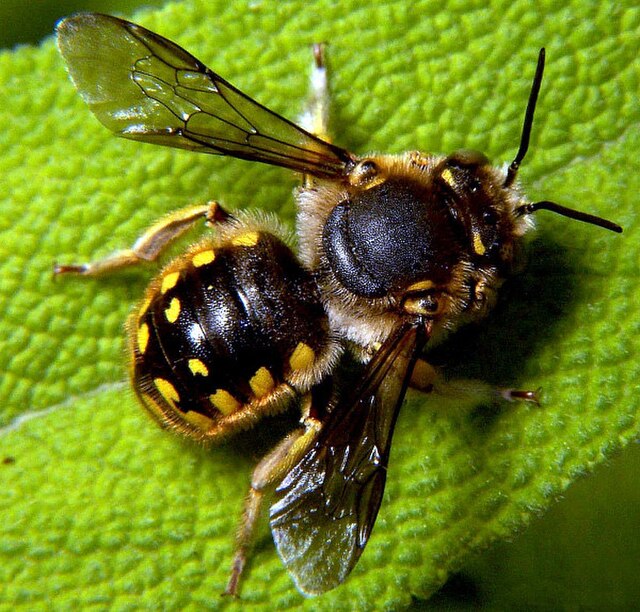
The European Woolcarder Bee (Anthidium manicatum) is native to Europe and Asia. It has made its way to North America where it lives in high numbers across multiple states.
The bee is mostly seen foraging blue flowers in Michigan. It collects pollen which is later used to feed emerging young bees.
The species is known for nesting underground. Unlike others, it creates balls out of the vegetation to lay eggs in.
It rolls up plant fibers until it creates a ball that can be rolled inside the nest. Once inside, the ball serves as a protective place to lay eggs and pollen.
15. Unequal Cellophane Bee
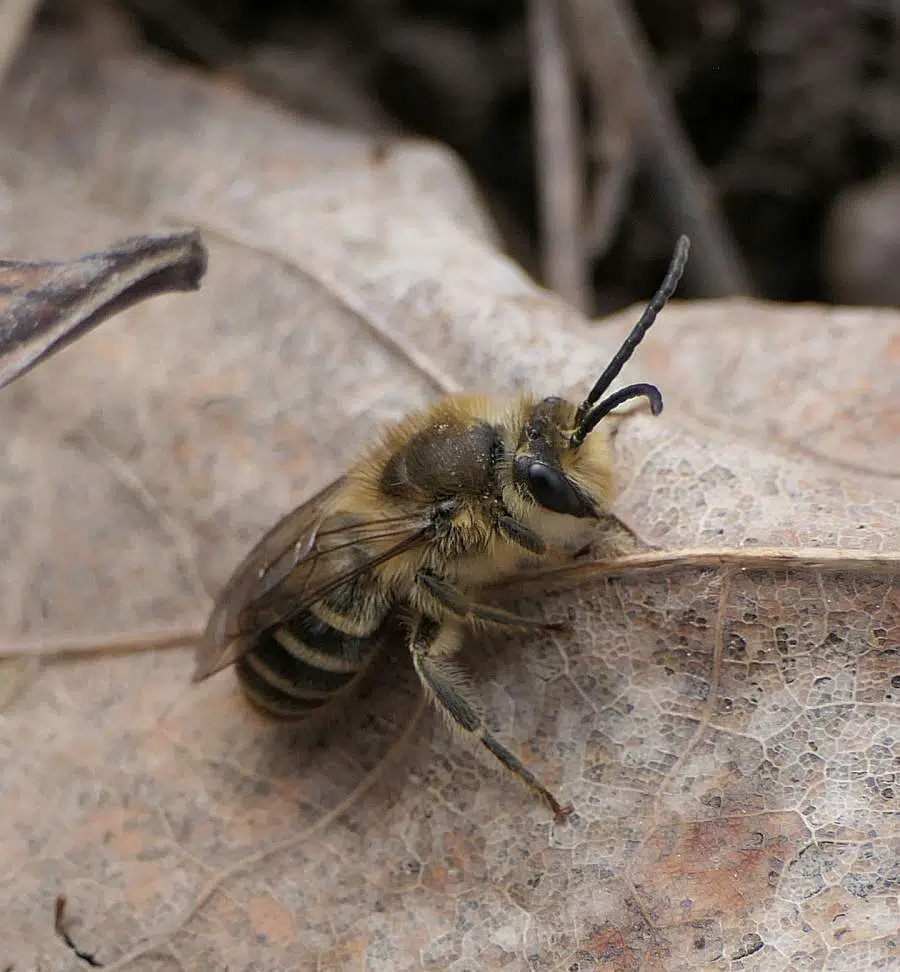
These bees (Colletes inaequalis) are some of the longest mining bees. They are recognized by their heart-shaped faces and by their daring behavior.
The first warm day of the year is the day these bees emerge. Sometimes they even emerge from underneath snow looking for flowers to feed on.
Underground nests are common for the species. These are tunnels with an opening of just a few inches and plenty of loose ground around them resembling volcanoes.
Following the first warm day, these bees begin looking for blossoms. They are particularly interested in red maple and shrubby willows blossom.
16. Perplexing Bumble Bee
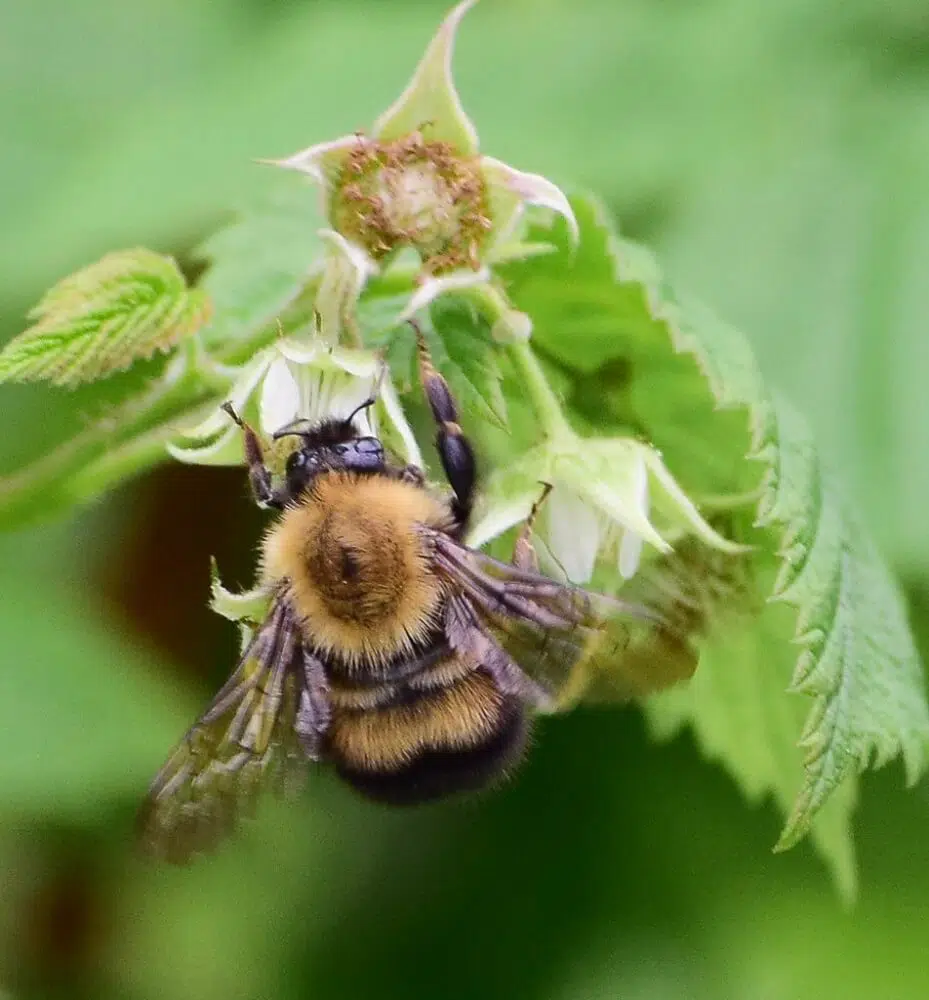
This species (Bombus perplexus) is often confused with other black and yellow bumblebees. However, it’s differentiated through an entirely yellow thorax.
The queen of the species is known for having more yellow hairs on the body, a larger size, and the capacity to lead worker female bees.
The species is common in wetland regions of Canada making its way to Michigan as well.
It prefers humid environments, woodlands, and urban gardens.
This species is a known pollinator sometimes confused with other bumblebees. However, it’s believed it prefers flowers such as bellflowers, thistle, honeysuckle, and rubus.
17. Yellow-banded Bumble Bee

The Yellow-banded Bumble Bee (Bombus terricola) has unique traits among common species in Michigan. It’s one of the bees that can regulate its body temperature.
This allows the Yello-banded Bumble bee to fly at low temperature, even below freezing temperature.
It achieves this capacity through exercising a lot of energy.
This bee is also very selective of the flowers it pollinates. The Yellow-banded Bumble Bee can pollinate up to 21 flowers per minute.
It does this by collecting pollen and visiting multiple flowers. This species has unique a unique capacity to visit the same flower where it hasn’t collected all pollen even when visiting more than a few flowers per minute.
The Yellow-banded Bumble Bee also has a unique capacity to establish and run a nest without a queen.
However, this can be a short-lived experience as it’s subject to parasitism from other species.
Given this circumstance and taking urbanization into consideration, the Yellow-Banded Bumble Bee has been put on the list of bee species with a population decline.
It has suffered a considerable decline in population across all Northern states over the past few decades.
18. Broad-handed Leafcutter
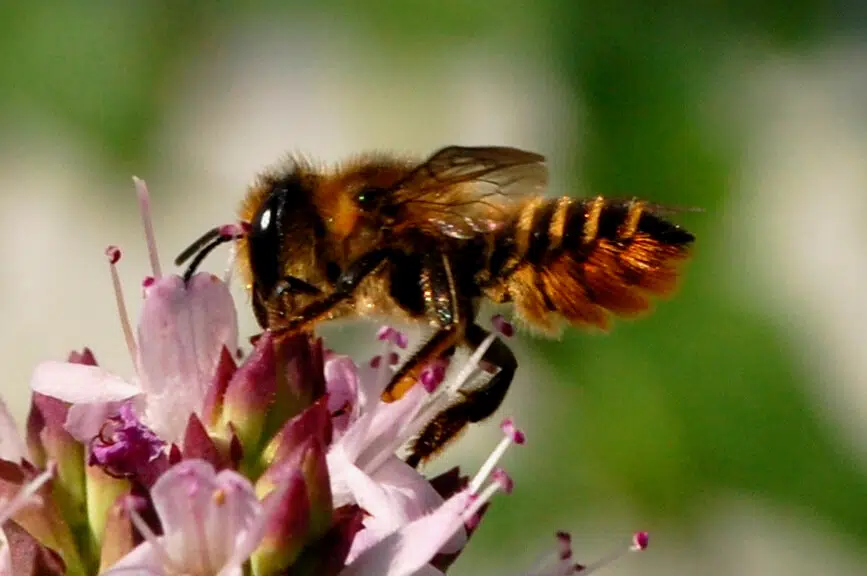
These leafcutter bees (Megachile latimanus) are known for their beneficial role in pollinating agricultural fields and flowers. They collect more nectar than pollen but they have an important role in the pollination of red clover.
These bees are known to be solitary. They go out during the day when they seek nectar and pollen from multiple plants and flowers.
Females are the only members of the species responsible for caring for young bees.
19. Oblong Woolcarder Bee

This species (Anthidium oblongatum) is known for nesting in dry rocks, underground, or in other similar crevices.
They are accustomed to living in the proximity of homes in urban areas. Nesting in wall cavities is common for this species when they are found around the house.
These bees are known for traveling long distances from the nest to the place where they collect pollen. As a result, they don’t need flowers in the backyard to nest around the house.
20. Pugnacious Leafcutter Bee

These leafcutter bees are known for their long mandibles and the ability to cut through vegetation such as leaves.
They are characterized by an innate ability to carry pollen. Soft hairs on their legs and abdomen allow female bees to carry pollen. Male bees have harder bristles which makes them less efficient at carrying pollen.
The Pugnacious Lefacutter Bee (Megachile pugnata) is known for its ability to pollinate sunflower, melon, and cranberries.
Pollen from these and other plants is collected and eggs are laid upon to serve as food. The bees emerge in early spring and remain active until the fall.
21. Golden Sweat Bee

Golden Sweat Bees (Augochlorella aurata) are attracted to human sweat, particularly to salty human sweat. They aren’t too dangerous for humans, however.
These bees are identified by a metallic green color. While they have a vivid color, these bees are smaller than others in Michigan as they rarely reach a body length of 7mm.
The historical habitat of these bees shows how they expanded around the Western part of North America both in the US and Canada.
Two generations or broods of Golden Sweat Bees emerge through the year. The first one appears in the spring while the other brood appears in the summer.
These bees prefer to live together in nests. However, there’s growing evidence to show exceptions to this rule exist as a growing number of Golden Sweat Bees are well adapted to living on their own.
22. Northern Amber Bumble Bee

The Northern Amber Bumble Bee (Bombus borealis) has yellow-golden and black lines across its thorax and abdomen. This species is native to North America and popular across the state.
Female bees nest underground. It’s here they lay eggs in and where they gather pollen.
Male bees typically live outside of the nest. Most male bees don’t travel far from the underground nests as they always wait for the next opportunity to mate.
Asters, thistle, and vetch are the main flowers the species is interested in.
23. Orange-legged Furrow Bee

The Orange-legged Furrow Bee (Halictus rubicundus) is one of the most studied species in the state and the country. Part of the research interest regarding this species is given by its ability to live both solitary and socially.
These bees have also been categorized among those who nest close to their natal nest. This process is called philopatry and it makes finding Orange-legged Furrow Bee individuals easy as they mostly nest close to their natal nests.
These bees dig nests in loose ground. These nests are mostly just a few inches deep. Many nests are found in loose soil particularly next to rocks.
It’s believed rocks can retain heat which is essential for how Orange-legged Furrow Bee nest.
24. Silky Striped Sweat Bee
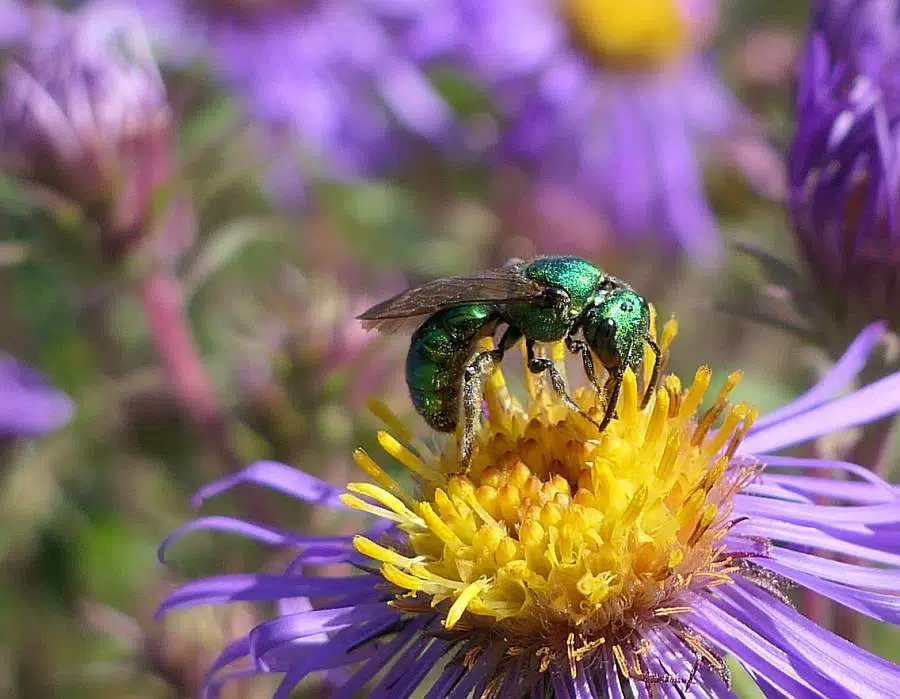
The Silky Striped Sweat Bee (Agapostemon sericeus) can follow people based on sweat attraction. This species is recognized by a green metallic body.
The head, thorax, and abdomen are of green metallic color. The legs are black with yellow hair.
25. Wilke’s Mining Bee

These bees (Andrena wilkella) are known for being adapted to collect as much aster pollen as possible. They have been accidentally introduced in North America and most other continents from Europe.
These are miner bees living in solitude, just like most other species. They live in the ground. Females dig a hole in the ground soon after mating.
Aster pollen is brought to the hole where eggs are laid. Afterward, female bees are also known for collecting pollen from febaceae plants.
26. Orange-tipped Wood-Digger
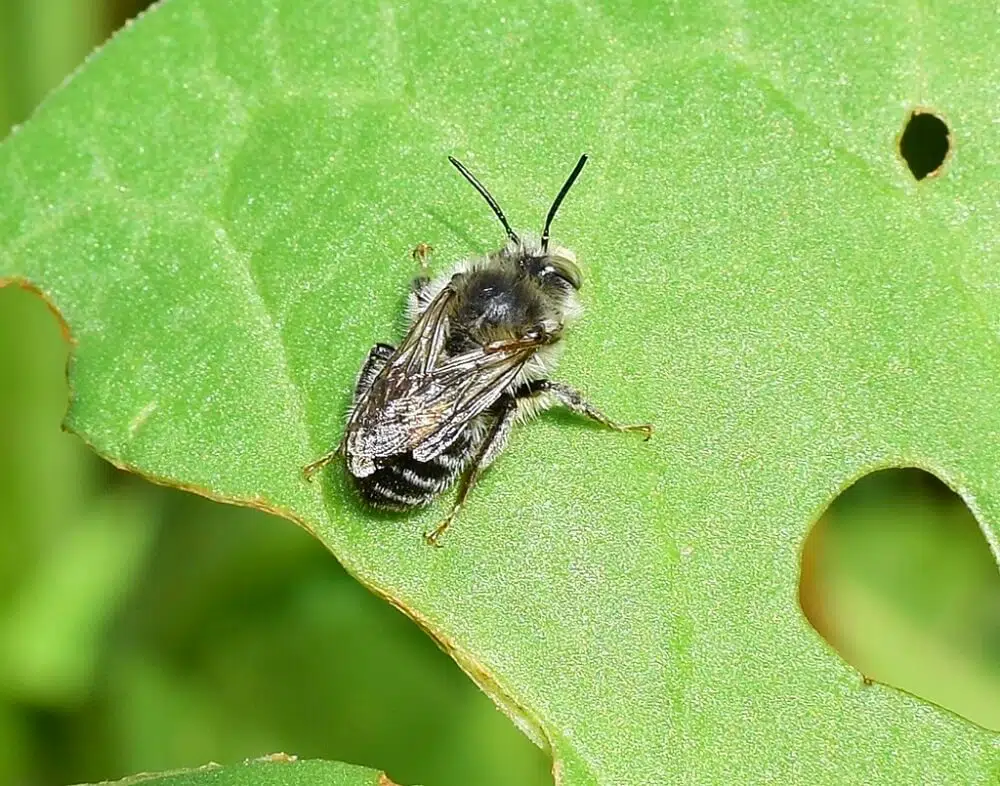
These bees are identified by the orange tip of the abdomen. It’s believed only females have this orange marking on the abdomen.
While common in the state and other Northern states, these bees are not extensively studied. What is known is that they have large tongues, an orange tip abdomen, and differing body coloration.
These bees are also known for having short soft hairs on the thorax and the abdomen.
They are known as digger bees. Most of these bees are seen when in the middle of the summer season.
However, their numbers aren’t as common as those of other bees in the state. Rarer sights are reported for Orange-tipped Wood-Digger bees (Anthophora terminalis) in neighboring states as well.
The preferred habitat for these bees is grassland and woodlands at varying altitudes as they’re adapted for living both at low and high altitudes.
Further Reading: